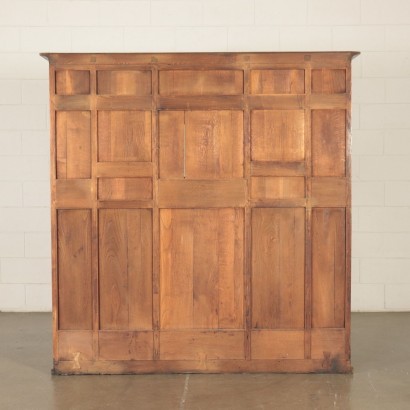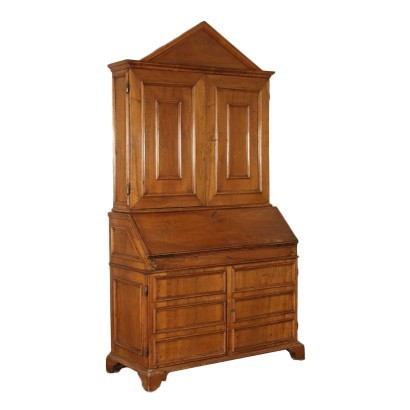Liberty Bookcase Art Nouveau Sessile Oak Brass Italy End 800 Early 900
Features
Style: Art Nouveau (1890-1920)
Age: 19th Century / 1801 - 1900 , 20th Century / 1901 - 2000
Origin: Italy
Main essence: Sessile Oak
Material: Brass
Description
Liberty bookcase, a rich succession of doors and open compartments with architectural designs: developed in a perfectly symmetrical way, the two lateral parts are made of glass doors, surmounted by an open space and another smaller glass door. In the central band there is a space on the lower part, surmounted by two small glass doors, a drawer and another space lowered with a pointed arch. The band under the frame has three compartments, on the top of the uprights there are two inserts in opal glass, nuanced from yellow to green, reprised on the sides to decorate the doors on the top. A glass door with a drawer and a space with a lowered pointed arch are on the sides as well. Sessile oak, decorated with refined symmetrical twists of ivy leaves, threaded with brass and inlaid with briar-wood. Interesting, on the front of the middle drawer, the writing "meminisse iuvabit" ("One day, we'll look back on this and smile"), from the Virgilian verse of the Aeneid and often used as a auspice that one day it will be pleasant to remember the current events.
Product Condition:
Fair condition. Wear consistent with age and use.
Dimensions (cm):
Height: 179
Width: 176,5
Depth: 55
Certificate issued by: Enrico Sala
Additional Information
Style: Art Nouveau (1890-1920)
Historical stylistic period formed from the end of the 19th century (ca. 1890) after the Umbertino style and continued until the First World War.The current was characterized by the floral influence and the soft and curved lines, typical example are the "whiplashes".
The first signs of this new era came from architects such as Hector Guimard (1867-1942) who created numerous buildings and hotels, but also from people such as Arthur Mackmurdo furniture designer and Arthur Liberty industrialist and London merchant of the late 19th century who began to produce furnishing fabrics with floral motifs with soft and sinuous shapes.
The Universal Exhibition of Paris in 1900 was an important point for the development and affirmation of Liberty in the following decade.
Liberty was called in different ways depending on the nation, universally known as Art-Nouveau and it is thought that Arthur Liberty is the origin of the name given in Italy to this beautiful stylistic movement.
The name Art-Nouveau is thought to derive from a shop located in Paris called Maison de l'Art Nouveau which began to show off furniture with a new and innovative design in its windows.
With the end of the First World War, the naturalistic period of Liberty ended and the Art-Decò style appeared, with more rigid and geometric lines.
Find out more about the Liberty style with our insights:
Art Nouveau: birth and development of a style
Milan Liberty between flowers and colors
Carlo Zen's Liberty
Decorative shapes and elegance in an Liberty living room
FineArt: Aeolus and Cupid, Liberty sculpture by Luca Madrassi
FineArt: Nymph and Faun, Liberty sculpture by Giuseppe Siccardi
The Austrian taste of Baroque








































